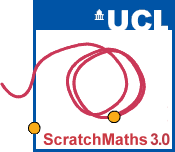
Background
In recent years the teaching of computer programming to children has become widespread. There has been an enhanced interest in introducing programming in school, both informally as part of after school 'coding' clubs and formally through the school. England is one of only a few countries that has made the teaching of programming a compulsory part of primary education to date, but many other countries are currently considering doing the same.
The teaching of computer programming in English schools is not new, with educational programming languages such as Logo widely used in both primary and secondary education settings during the 1980s and 90s. However, research to date has been mixed and the findings inconclusive (Clements 1999; Voogt et al. 2015), but there have been significant technological developments in novice programming environments since much of this previous research was conducted. The ScratchMaths (SM) project seeks to explore this current potential in depth for the 9-11 primary age group (upper Key Stage 2) in light of the recent curriculum changes in England, which have initiated a renewed enthusiasm and motivation for the teaching of programming in schools.
We seek to redress the lack of clarity concerning, for example, computational thinking, the role programming plays in its development, and the relationship between learning to program and learning to express mathematical ideas through programming.
References:
Clements, D.H., 1999. The future of educational computing research: The case of computer programming. Information Technology in Childhood Education Annual, 1, pp.147-179.
Voogt, J. et al., 2015. Computational thinking in compulsory education: Towards an agenda for research and practice. Education and Information Technologies, 20(4), pp.715-728.
- Overview of Research
The project is an efficacy trial developing and evaluating the effect of learning to program on understanding computational thinking and mathematical thinking. Our focus is two-fold.
- A team of independent evaluators based at Sheffield Hallam University is comparing the performance on selected tasks of students' mathematical thinking with those who do not engage with the materials and programming activities. One cohort of pupils in 50+ schools (100 classes) are engaging in a two-year programme, the first year focusing on computational thinking and Scratch programming, and the second year on the learning of mathematical thinking through engagement with a specially designed programming-mathematics curriculum.
- Our team at UCL Knowledge Lab is designing and testing the materials aligned with both the Primary Computing and Primary Mathematics National Curriculum and collecting data on learning trajectories of pupils and the roles played by their teachers.
In each year of the intervention, (ideally) two teachers in each school were trained in the use of Scratch programming and the curriculum materials. Training will took place over two days. In year one of the intervention, the target group of teachers was two teachers in each school, which included one Year 5 (Y5) teacher and an ICT coordinator or another Y5 class teacher in each school. In year two, the target group where possible were two Year 6 (Y6) teachers, who were trained to continue the approach with the same cohort of children or the Y5 teacher who had delivered the intervention the year before. In addition to the face-to-face teacher professional development (PD), there has been an online community providing support and some optional half-day sessions during the year.
The team from Sheffield Hallam (SHU) are leading on the quantitative evaluation. The research design is a Clustered Randomised Control Trial (CRCT) with 3 levels: pupils are clustered into classes which are clustered into schools. Schools were randomised to either the treatment or a wait-list control group. The primary outcome measure is the KS2 mathematics test scores at the end of Y6. An intermediary secondary measure undertaken at the end of year one of the intervention is a measure of aspects of computational thinking appropriate to the age range. Measuring computational thinking at the end of year one addresses the intended outcomes of the first year of the trial where the focus is on computing and computational thinking. In addition, it allows analysis at the end of year two, of the relationship (if any) between measured differences in computational thinking and the impact on mathematics attainment.
The team from the UCL Knowledge Lab are leading on the qualitative evaluation. It focuses on how the curriculum materials are used by teachers and engaged with by pupils as well as observed qualitative outcomes of this. In addition, teachers engagement' with professional development and the outcomes of this is explored. The intention is to identify causal mechanisms to help explain the outcomes of the quantitative evaluation. This research is focused around the following specific ideas:
- The gap between curriculum design and implementation
- Pupil understanding of algorithm
- Affordances of computer programming for mathematics learning
- Evolution of teacher mathematics knowledge
- Pupil affect
 Close
Close


